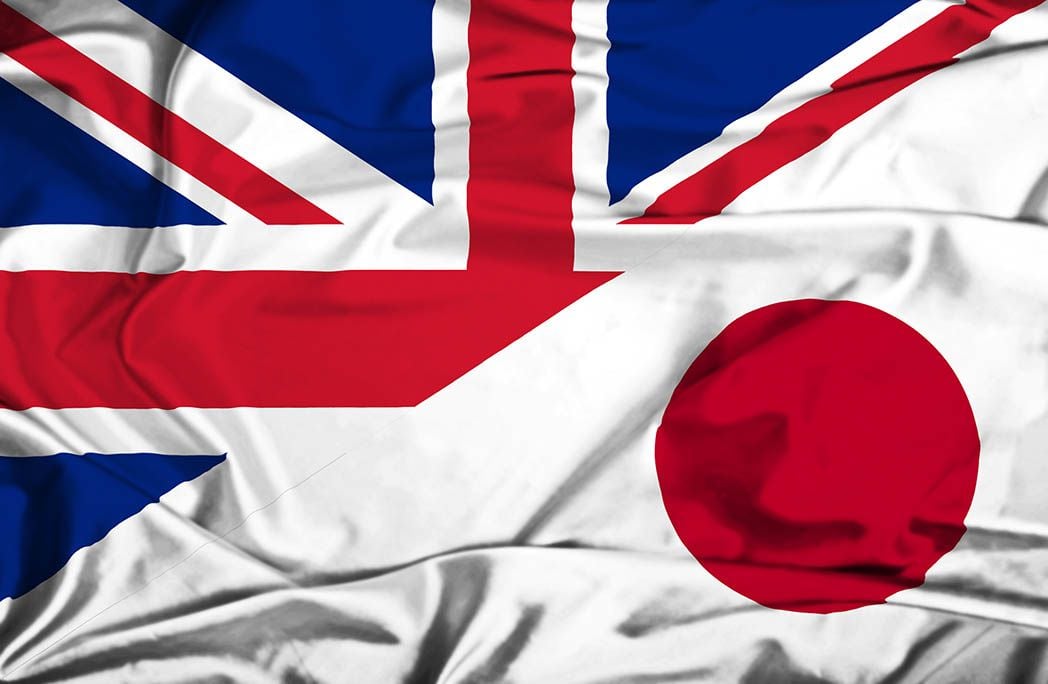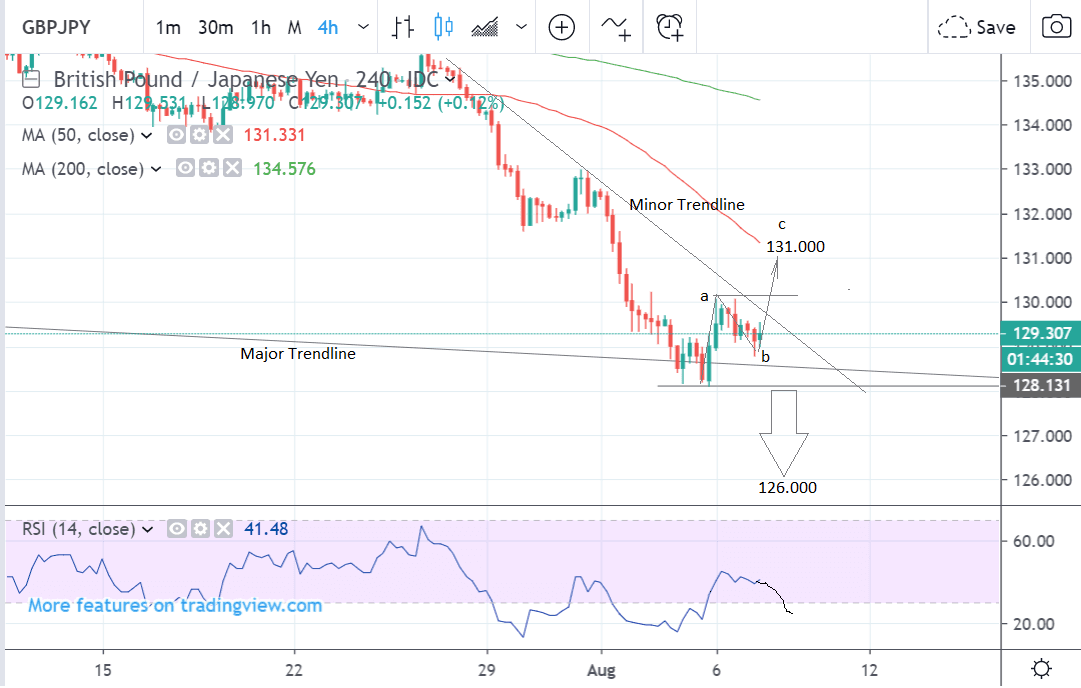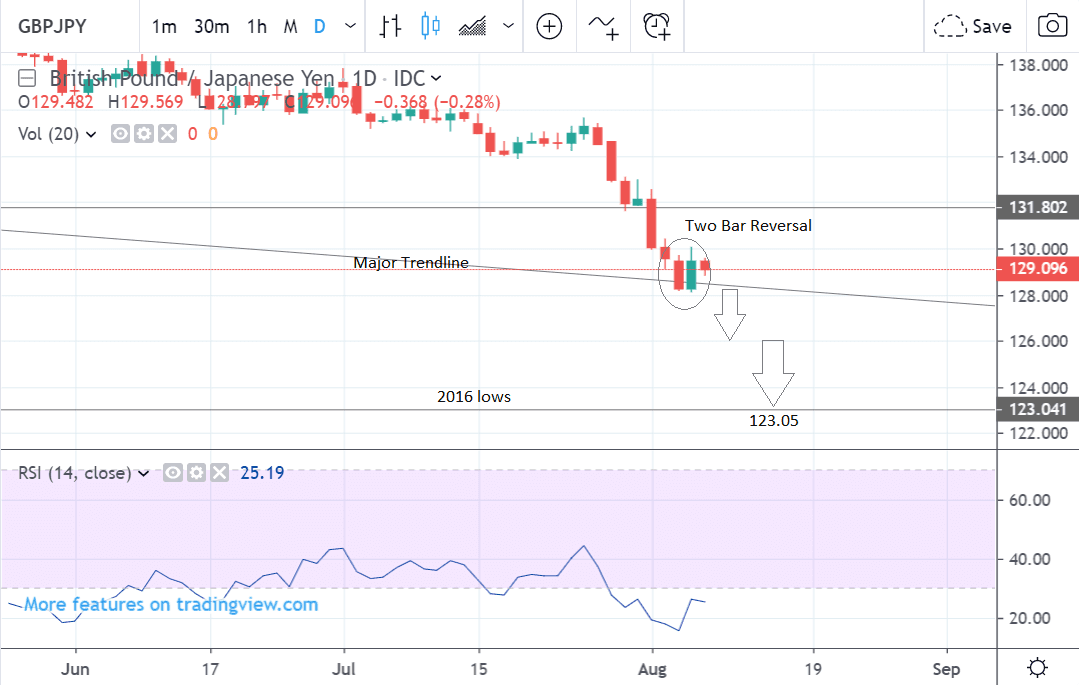Pound-Yen Outlook: Marginal Bearish Bias on Account of Dominant Trend

Image © Adobe Stock
- GBP/JPY hits major support level and bounces
- Overarching trend still bearish
- Yen to be driven by global risk trends and GDP
The Pound-to-Yen exchange rate is trading at around 129.26 at the time of writing, up around 0.50% so far this week.
Studies of the charts suggest evidence for both a decline and a recovery in the days to come, with the bearish view having a marginal advantage given the dominant downtrend.
The 4-hour chart - used to determine the short-term outlook, which includes the coming week or next 5 days - shows the pair rebounding after it fell temporarily below a major multi-year trendline.
These trendlines often provide a support floor for a reversal. So far it is too early to say whether this will be the case this time or whether the pair will simply continue falling.
The downtrend is still intact and because the trend trump's all other considerations the pair is biased to continue lower, yet given the substantial support underpinning the lows and the risk of a reversal we would be looking for a break below the 128.13 lows for confirmation.
The pair is pulling back after mounting a strong recovery on August 5. It looks like this may be the B leg of a three-wave ABC correction. If so, the final C leg higher may be about to unfold and see the pair move up to a target at 131.00.
A break above the 130.07 highs would confirm an extension higher to a target at 131.00.
The daily chart shows the downtrend touching support at a major trendline which is also the lower border of a falling wedge pattern
The downtrend is intact and this trump's all other considerations so the pair is forecast to continue lower conditional upon a break below the current 128.13 lows. Such a break could open the way up for a fall down to a target at 123.05, at the 2016 lows.
Nevertheless, there are also contrary signals which suggest a risk of a reversal higher.
The first is that the pair has formed a bullish two-bar reversal pattern at the August 5 and 6 lows. This consists of a long red down-bar followed immediately by a long green up-bar of a similar length and with a similar high and low.
Two bar reversals are quite reliable reversal signals.
Another bullish sign is that the RSI momentum indicator is in oversold territory and turning higher, which could suggest a pause in the downtrend due to prices having reached oversold extremes. Whilst this may indicate the pair will stall or consolidate for a time it is not enough to negate the bearish bias altogether.
The daily chart is used to give an indication of the outlook for the medium-term, defined as the next week to a month ahead.
The weekly chart - used to give us an indication of the outlook for the long-term, defined as the next few months - shows how the exchange rate has fallen to the bottom of a large wedge pattern which the pair has been forming since the start of 2018.
Although wedge patterns are generally considered bullish the exchange rate has most recently been falling within the pattern after a false breakout at the start of the year.
The downtrend is entrenched and could still slide lower to an eventual target at the 123.05 level of the 2016 lows, given the saying that 'the trend is your friend'.
Nevertheless, bullish signs are also apparent: the RSI momentum indicator is now deep in the oversold zone and the pair has touched the bottom of the pattern suggesting the increased probability of a bounce from the current level - so there is a risk of a bounce higher.
The 2016 lows are likely to provide a solid floor of support and there is a high chance the pair may bounce at that level before considering the possibility of a continuation lower.
Time to move your money? Get 3-5% more currency than your bank would offer by using the services of foreign exchange specialists at RationalFX. A specialist broker can deliver you an exchange rate closer to the real market rate, thereby saving you substantial quantities of currency. Find out more here. * Advertisement
The Japanese Yen: The Big Drivers
The main fundamental driver of the Yen in the week ahead is likely to be market sentiment since the Yen acts like a safe-haven currency, rising when investors are fearful and falling when they are optimistic.
At the start of the week, the Yen made huge gains after sentiment soured due to a deterioration in trade relations between the U.S. and China, however, as we reach midweek sentiment has improved after the People's Bank of China (Pboc) intervened to support the Yuan which had devalued massively. This put paid to U.S. accusations it was a currency manipulator.
“Market sentiment has improved slightly, helped by the PBoC’s actions yesterday, while the US-China trade war remains in focus. US equities are stronger and UST yields are slightly higher across the curve,” says Jason Wong, an analyst at BNZ.
There is a high risk, however, sentiment could worsen again if there is another trade war flare-up, and if this was the case it would support the Yen.
The Japanese currency is at risk of depreciation due to a possible change in stance by the U.S. Federal Reserve (Fed). The Fed had been quite cautious about the economic outlook which was the reason it cut interest rates by 0.25% at its last meeting - a form of ‘insurance cut’ if things worsened.
Recent commentary from the least positive member of the Fed, James Bullard, however, suggests the Fed may not see any need to cut rates any further. Bullard essentially said that the Fed could not react to every twist and turn in talks between China and the U.S. and seemed to suggest the cut may be a ‘one and done’ affair. The implication is that the U.S. economy may be holding up relatively well.
“Fed President Bullard became the first FOMC member to publically comment since the trade war escalated and despite his uber-dovish tendencies his message was one of wait-and-see than an urgency to slash rates. He commented that “US monetary policy cannot reasonably react to the day-to-day give-and-take of trade negotiations”. While he didn’t rule out more policy changes ahead he noted that Fed policy was considerably more accommodative than late 2018,” says Wong.
On the domestic data front, the main release is Q2 GDP data on Thursday, which is forecast to show a 0.1% rise from 0.6% in Q1 and a 0.4% rise compared to a year ago - from 2.2% in Q1.
Whilst no-one is expecting Japanese GDP to fluctuate majorly, there is always a risk of large move higher or lower, which would impact on the Yen. A move higher would support the currency, whilst a move lower would weigh.
Looking at some of the economic data already released for the quarter - inflation has come off a little after rising in Q1 (negative), unemployment has fallen to a new record low of 2.3%, (positive), the trade balance has oscillated (neutral), business confidence has fallen to a very low level in July 2019 (negative), Manufacturing PMI has fallen (negative), Services is flat (neutral), corporate profits increased (positive) but consumer confidence has declined (negative).
The data so far suggests a marginally lower rate of GDP growth in Q2 in line with the 0.1% consensus estimates.
Time to move your money? Get 3-5% more currency than your bank would offer by using the services of foreign exchange specialists at RationalFX. A specialist broker can deliver you an exchange rate closer to the real market rate, thereby saving you substantial quantities of currency. Find out more here. * Advertisement


